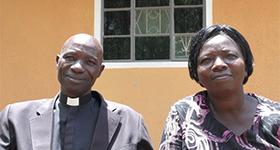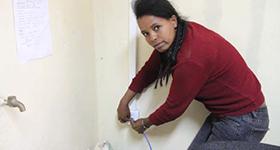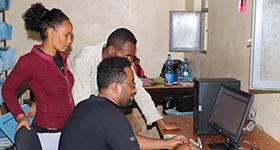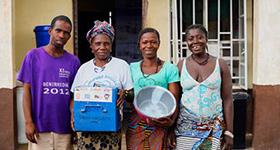Background
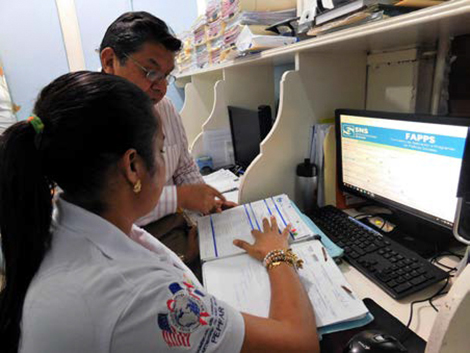
Data entry clerk Jasmine Sosa receives on-the-job training from APC/DR M&E officer Franz Gonzales-Bedoya. Photo:Ángela de León, JSI/APC
At the end of March 2018, there was a 71 percent data discrepancy between pre-ART patients reported in the government’s FAPPS database (a component of the national HIV services information system) and the pre-ART patients reported after reviewing medical records at the six clinical sites supported by the Advancing Partners & Communities (APC) project in the Dominican Republic (DR). In absolute numbers, the electronic system was reporting that as many as 561 patients had not yet started ART, but the clinics were reporting an ‘on treatment’ gap of only 164. Pre-ART, or “in-care,” means that the patient and the clinic know that the person is HIV positive and has been registered at the clinic, but has yet to begin treatment which could be for a variety of reasons. In 2016, the GODR adopted the WHO recommendation that everyone with HIV be offered ART as soon as they are diagnosed. This strategy, known in the DR as “Treatment for All”, is also known as “Test and START.” APC provides public and NGO clinical sites with technical and management support to implement the PEPFAR-supported “Treatment for All” strategy that aims to initiate patients on ART immediately after a positive HIV diagnosis to assist the government in reaching its 90-90-90 treatment target to achieve epidemic control by the year 2020.
Like the data entry personnel at other APC-supported sites, Vanessa Cruz Areché, José Manuel Félix, and Jasmine Sosa, HIV clinic data-entry technicians at the Francisco Gonzalvo Hospital, Ricardo Limardo Hospital and CEPROSH HIV clinic, were instrumental in improving the data completeness, accuracy and quality in the national FAPPS database. With up-to-date national information on HIV patient load and status, the DR and donor agencies have better information to make informed policy, planning and budgeting decisions to respond to and manage the epidemic. Without accessible and reliable data, the HIV epidemic cannot be managed effectively or efficiently.
With technical assistance from the APC project, by the end of June 2018, the six APC-supported clinical sites had reduced the discrepancy between the data on pre-ART patients reported in the FAPPS and the data reported by APC from the patient medical records (the primary data source) to only 10 patients (or 2 percent).
Intervention
In October 2017, APC began assisting with data entry and record-keeping at the clinical sites to improve timeliness, completeness and accuracy of data in the FAPPS forms, the FAPPS database, and patient medical records. APC funded salaries for additional data entry staff where needed to ensure more timely and accurate data entry into the FAPPS system. APC provided hands-on training in ways to enter data and perform data quality checks. APC also worked with clinics to review filing systems, record-keeping, and institute more efficient data management approaches.
During the third quarter of FY 2018 (April–June), APC supported the sites’ data-entry and records management staff to conduct a data validation and cleaning exercise to cross-check and update the status of patients reported as in care (pre-ART) in the FAPPS database who are actually on ART as reported in the patient´s medical record at five of the six APC-supported clinical sites.
"The first task was to filter the list of patients registered as in care (pre-ART) from the FAPPS database. From the printed list, we were able to verify the ID number assigned to each patient in the FAPPS. We then looked up those medical records in the files to cross-check if the patient was currently in care (pre-ART status) or had started antiretroviral therapy,” explains José Manuel. While tedious updating is often left as a last task in a busy clinic, it must be scheduled and done regularly.
Reduction in number of pre ART patients reported in FAPPS as result of APC data validation and cleaning exercise: March September 2018
| APC-supported clinical site | No. patients in care (pre-ART) March 2018 | No. patients in care (pre-ART) September 2018 | Percentage (%) reduction |
|---|---|---|---|
| Francisco A. Gonzalvo Hospital | 112 | 25 | 78% |
| CEPROSH | 106 | 56 | 47% |
| Clínica de Familia | 78 | 58 | 26% |
Vanessa affirms, "This exercise allowed us to identify several cases where patients documented as “on treatment” on the FAPPS form in the medical record did not match the electronic record in the FAPPS database, and as a result, we had to make the appropriate adjustments.¨ This is important because the data from the FAPPS system is what is being reported and used by decision-makers at regional and national levels of the government and by donors supporting efforts to control the HIV epidemic.
Jasmine indicates that "the exercise allowed us to identify the patients in care who were actually on treatment, and even patients in care who were not patients at CEPROSH, but were listed in the CEPROSH FAPPS.” This is critical because not only does it allow the FAPPS to be up to date and accurate, but gives clinic program managers a clearer sense of who and how many patients need to be reached and counseled to begin ART.
Outcomes
The impact of this data validation and cleaning exercise is essential to provide quality management information for monitoring the "Treatment for All" strategy. According to the FAPPS summary reports, at the end of March 2018, 7 percent of the patients at the six APC-supported clinical sites were still in care (pre-ART), (561 of the total 8,680 patients receiving services at the sites), whereas by the end of September, after the updating intervention, the percentage of patients reported as in care dropped to 4 percent (401 of the total 9,167 patients).
The largest contributor to closing the gap in the number of patients reported as in care between March and September 2018 was the Francisco Gonzalvo Hospital with a 78 percent reduction, followed by CEPROSH at 47 percent, and Clínica de Familia at 26 percent.
While in March of this year, overall concordance between the FAPPS electronic system and the APC data that is based on manual review of patient records was only 29 percent, by September, it had jumped to 96 percent.
By the end of September, 96 percent (8,766 of 9,167) of the patients at the APC-supported clinics were on ART. The APC contribution to patient burden in the DR is impressive—23 percent of the 37,989 patients reported on treatment in the FAPPS database at all 73 HIV clinics in the country.
Based on her experience, Vanessa emphasizes, "This is not about typing in the information, this work requires a thorough examination of each record, including updating all the diagnostic test results, since these are also registered in the FAPPS. I would say the FAPPS is extremely important, but it is only as reliable as the quality of the data. Effectiveness depends on quality data input…the information has to be specific, concise and correct."
According to José Manuel, "It was a learning process. Now, I am very careful when filling out the FAPPS, making sure that all the data is transferred to the computerized system with the highest accuracy.”
Jasmine qualifies this experience as excellent. "It allowed us to identify the problems with FAPPS and my own data entry problems. We are continuing with the exercise to prevent data bottlenecks and avoid reporting patients who have transitioned to treatment as in care, as was the case before.”
Given the results of this exercise at the APC-supported sites, the National Health Service, responsible for management of the national HIV services information system, has requested technical assistance from APC to conduct a national-level data validation and cleaning exercise at all 73 HIV clinics.

